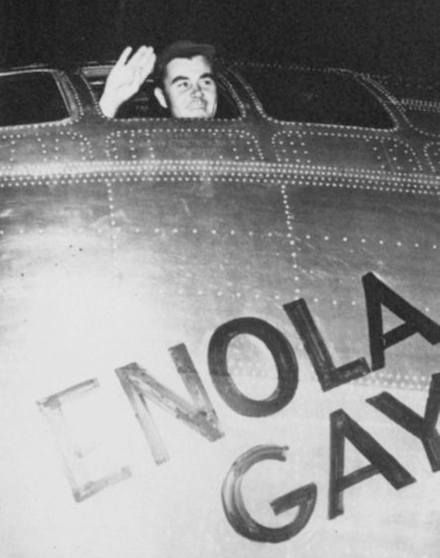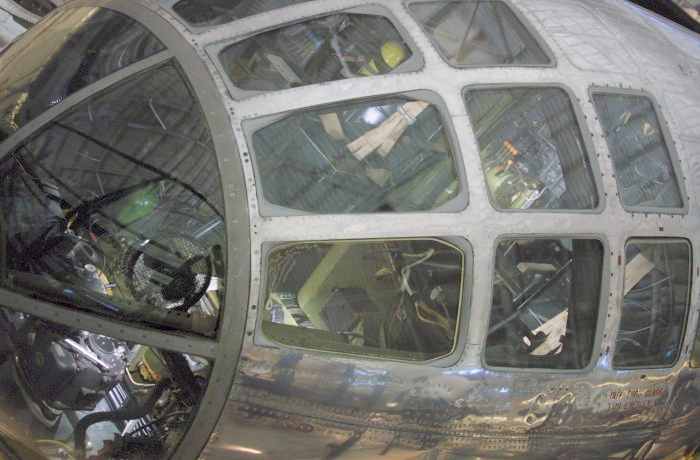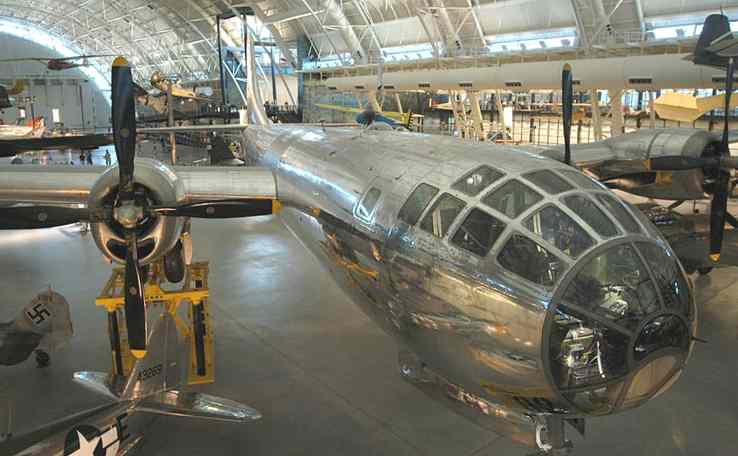|
ENOLA GAY
|
||
|
HOME | BIOLOGY | FILMS | GEOGRAPHY | HISTORY | INDEX | INVESTORS | MUSIC | SOLAR BOATS | SPORT |
||
|
Enola Gay is the B-29 Superfortress bomber that dropped "Little Boy", the first atomic bomb ever used in warfare, when the United States Army Air Forces (USAAF) attacked Hiroshima, Japan on August 6, 1945, just before the end of World War II. Because of its role in the atomic bombings of Japan, its name has been synonymous with the controversy over the bombings themselves. The plane gained additional national attention in 1994 when an exhibit at the National Air and Space Museum of the Smithsonian Institution was changed due to a controversy over its historical script. In 2003, Enola Gay went on display at NASM's new Steven F. Udvar-Hazy Center annex near Dulles International Airport in Virginia.
Colonel Paul Tibbets waving from Enola Gay's cockpit before the bombing of Hiroshima
Bombing of Hiroshima
Enola Gay (B-29-45-MO, serial number 44-86292, victor number 82) was assigned to the USAAF's 393rd Bomb Squadron, 509th Composite Group and flew the August 6 mission out of Tinian, a large island with several USAAF bases in the Mariana Islands chain. The plane was one of 15 B-29s with the final "Silverplate" modifications necessary to deliver nuclear bombs. Enola Gay was built by the Glenn L. Martin Company at its Omaha, Nebraska, plant and personally selected by Colonel Paul W. Tibbets, Jr., commander of the 509th Composite Group, on May 9, 1945 while still on the assembly line as the B-29 he would use to fly the atomic bomb mission.
The airplane was accepted by the USAAF on May 18, 1945, and assigned to Crew B-9 (Capt. Robert Lewis, aircraft commander), who flew the plane from Omaha to the 509th's base at Wendover Army Air Field, Utah, on June 14, 1945. Thirteen days later it left Wendover for Guam, where it received a bomb bay modification, and flew to Tinian on July 6. It was assigned victor number 12, which was later changed to 82. After flying eight training missions and two combat missions during July, the plane was used on July 31 on a rehearsal for the actual mission, with a dummy Little Boy assembly dropped off Tinian.
On August 5, 1945, during preparation for the first atomic mission, Tibbets had the plane named after his mother, Enola Gay Tibbets (1893–1983, who had been named for the heroine of a novel). According to Gordon Thomas and Max Morgan-Witts (Enola Gay, Stein & Day Pub, 1977), regularly assigned aircraft commander Robert Lewis was unhappy to be displaced by Tibbets for the important mission, and furious when he arrived at the aircraft on the morning of 6 August to see it painted with the now-famous nose art. Tibbets himself, interviewed on Tinian later that day by war correspondents, confessed that he was a bit embarrassed at having attached his mother's name to such a fateful mission.
The Hiroshima mission has been described as tactically flawless, and Enola Gay returned safely to its base on Tinian to great fanfare on the base. The first atomic bombing was followed three days later by another B-29 (Bockscar) (piloted by Major Charles W. Sweeney) which dropped a second nuclear weapon, "Fat Man", on Nagasaki. The Nagasaki mission, by contrast, has been described as tactically botched; although it met its objectives, it encountered a number of mistakes in execution and Bockscar had barely enough fuel to make an emergency landing on Okinawa. On that mission Enola Gay, flown by Crew B-10 (Capt. George Marquardt, aircraft commander, see Necessary Evil for crew details), was the weather reconnaissance aircraft for Kokura.
The cockpit of Enola Gay
Subsequent history
On November 6, 1945, Lewis flew the Enola Gay back to the United States, arriving at the 509th's new base at Roswell Army Air Field, New Mexico, on November 8. On April 29, 1946, Enola Gay left Roswell as part of Operation Crossroads and flew to Kwajalein on May 1. It was not chosen to make the test drop at Bikini Atoll and left Kwajalein on July 1, the date of the test, and reached Fairfield-Suisun Army Air Field, California, the next day.
The decision was made to preserve the aircraft and on July 24, 1946, it was flown to Davis-Monthan Air Force Base, Arizona, to prepare it for storage. On August 30 title to the aircraft was transferred to the Smithsonian Institution and it was removed from the USAAF inventory. It then went through temporary storage at a variety of locations:
Restoration was finally begun on December 5, 1984, at the Paul E. Garber Preservation, Restoration, and Storage Facility in Suitland.
Recent developments
Enola Gay became the center of a controversy at the Smithsonian Institution in 1994, when the museum put its fuselage on display as part of an exhibit commemorating the 50th anniversary of the atomic bombing of Hiroshima. The exhibit, 'The Crossroads: The End of World War II, the Atomic Bomb and the Cold War' was drafted by the Smithsonian's National Air and Space Museum and arranged around a restored version of Enola Gay. Critics, especially the American Legion and the Air Force Association, charged that the exhibit focused too much on the casualties wrought by the bomb rather than on the motivations for the bombing or discussion of its role in ending the war. The exhibit brought to national attention many long-standing academic and political issues related to retrospective views of the bombings (Atomic bombings of Hiroshima and Nagasaki), and in the end, after attempts to revise the exhibit to meet the satisfaction of competing interest groups, the exhibit was cancelled on January 30, 1995, though the fuselage did go on display. On May 18, 1998, the fuselage was returned to the Garber Facility for final restoration.
The entire plane has since been restored for static display and is currently a major permanent exhibit at the National Air and Space Museum's Steven F. Udvar-Hazy Center near Dulles International Airport outside Washington, D.C. As a result of the earlier controversy, the signage around the plane provides only the same succinct technical data as other aircraft in the museum, without discussion of controversial issues. The aircraft is shielded by various means to prevent a repetition of vandalism which was attempted against it when it was first placed on display.
The four lightweight aluminum variable pitch propellers that were used on the bombing mission to save weight ended up at Texas A&M University. One of them, trimmed to 12.5 feet, provides the thrust for the Oran W. Nicks Low Speed Wind Tunnel. A 1250 kVA electric motor provides constant revolutions (900 RPM) and the propeller's pitch/yaw is changed to control the wind-speed (up to 200 mph) in the tunnel.
Enola Gay today at the Steven F. Udvar-Hazy Center
Mission personnel
Enola Gay's crew on August 6, 1945 consisted of twelve men:
LINKS
AVIATION A - Z
A taste for adventure capitalists
Solar Cola - a healthier alternative
|
||
|
This
website
is Copyright © 1999 & 2013 NJK. The bird |
||
|
AUTOMOTIVE | BLUEBIRD | ELECTRIC CARS | ELECTRIC CYCLES | SOLAR CARS |


